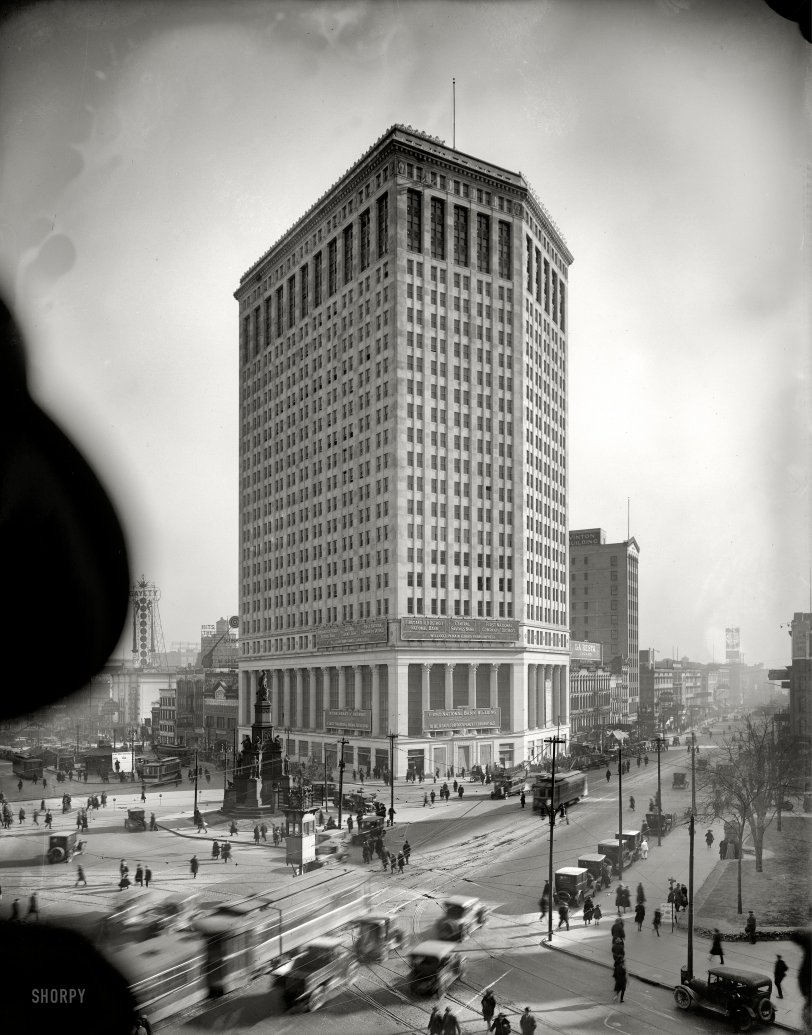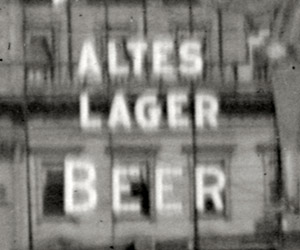


Framed or unframed, desk size to sofa size, printed by us in Arizona and Alabama since 2007. Explore now.
Shorpy is funded by you. Patreon contributors get an ad-free experience.
Learn more.

- Baldwin 62303
- Baldwin VO-1000
- Cold
- No expense spared
- Tough Guys
- Lost in Toyland
- And without gloves
- If I were a blindfolded time traveler
- Smoke Consumer Also Cooks
- Oh that stove!
- Possibly still there?
- What?!?
- $100 Reward
- Freeze Frame
- Texas Flyer wanted
- Just a Year Too Soon
- WWII -- Replacing men with women at the railroad crossing.
- Yes, Icing
- You kids drive me nuts!
- NOT An Easy Job
- I wonder
- Just add window boxes
- Icing Platform?
- Indiana Harbor Belt abides
- Freezing haze
- Corrections (for those who care)
- C&NW at Nelson
- Fallen Flags
- A dangerous job made worse
- Water Stop
Print Emporium
First National: 1921

Detroit, Michigan, circa 1921. "First National Bank." The building that replaced the enormous but short-lived Hotel Pontchartrain, a favorite subject of the Detroit Publishing Co. along with the Soldiers and Sailors Monument, another landmark seen here in the vicinity of Cadillac Square and the Campus Martius. Note the traffic control tower and the tally board labeled DETROIT STREET TRAFFIC KILLINGS. 8x10 inch dry plate glass negative. View full size.
Acanthus leaf, huh?
I bet you're both right, but I liked the "Cresting of finials guarding their young" better! Thanks tterrace.
Green bottled beer
It's Altes Lager (German for "old lager"). You can just see the crossed "t" in the sign. Altes (motto: "Tastes like Fassbier") was a old Detroit brewery that passed the Altes brand to various successors. I picked up a case circa 1982. Here's a label, whose lettering looks quite similar to the sign.
[Thanks to you and Alex for solving that mystery. Evidently one of the breweries that survived Prohibition. - Dave]
Brewski
That sign may be for Altes Lager Bier from Detroit's Tivoli Brewing Company. It came in green bottles.
[You are correct. Below is a detail from a circa 1918 photo of the Hotel Pontchartrain showing an Altes Lager sign that was across the square from the where the other sign would be a few years later. - Dave]

In the name of all humanity
I think it's useful to keep a tally of traffic deaths, but cheese Louise, did they have to hang the most recent body right there on the sign? I wonder if his dear mournful widow found a ticket stub to the Gayety in his overcoat.
Architectural Thingamabob
I'd call that a cornice. Acanthus leaf motif.
Drink Alle____ in Green Bottles
Can anyone identify the tasty drink that "hits the spot," that was advertised on the partially-obscured roof sign between the bank and the Gayety theatre? (It's in the same spot that a baking powder was advertised in the 1918 photo of the Pontch.) Since Michigan had in theory been dry since 1918, and the sign wasn't up before 1918, it wouldn't be a brand of beer or other booze. It seems to start with the letters "Alle," so it's not Vernor's.

Doodads
bryharm's comment sent me questing for technical verbiage of the architectural kind. What we have along the edge of the roof, unfinished, could be described as a cresting of finials. Guarding their young.
Sandwich Board
I think you meant: "the sandwich board on the lower RIGHT."
Looks like an ad for something. Can we get any closer Dave?
[It says "Where Marines T____" - Dave]
The Gayety
I am always loving all the extra research everybody does on the monuments, people, and locations in the pictures, so here's something I found about the large burlesque theater in the background.
The Gayety, designed by Fuller Claflin, seated 1,362 and opened Sept. 15, 1912. For the theater's entire career, it held burlesque. It was once operated by Frank Bryan and Frank Engel.
The Gayety closed April 10, 1958, and was demolished soon thereafter. Today, a parking lot resides on the property. More pictures here.
[And another view here. - Dave]
Sandwich anyone?
Can anyone make out the sandwich board on the sidewalk in the lower left?
[Left? - Dave]
Sorry, I must've been looking in the mirror.
Impressive Lobby
The architecture firm for which I used to work was planning to occupy the second and third floors (the tall windows with the colonnade). The original bank lobby was in this space and was a beauty: marble columns, gold leaf ornamentation, huge chandeliers and such; you definitely got the feeling that this was an institution to be reckoned with. Sadly, in 1974 they gutted the entire space and divided it with a floor, the better to have more space to lease. When our firm made plans to move in, all the modernizations were removed to reveal some interesting features: the original vault, intact original elevator annunciators, original doors that were walled off for decades and a few surviving ornamentations. Our firm created plans to preserve as much as possible while still having an ultramodern feel; sadly we were not able to go through with the lease at that time.
The intersection is now replaced by Campus Martius Park. Still not any safer, though.
Almost Done
You can move right in just as soon as we finish putting up those fancy little doodads on the roof!
The building is still there, but, sadly, the doodads are gone. And you can hardly see the Soldiers' and Sailors' Monument anymore for all the shrubbery and new age beautification in the square. Municipal lipstick, I s'pose.
Traffic deaths
It's no wonder so many people are killed. That intersection is nuts!
























On Shorpy:
Today’s Top 5